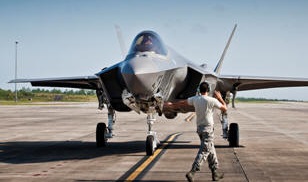|
Following slightly differing time frames, their
individual giving has grown enormously since the JSF
program started in 1997.
The main contractor, Lockheed, and Northrop
Grumman led the pack in 2014, each contributing $4.1
million to campaigns. UT spent $2.1 million, and BAE
gave $1.4 million. For all four, 2014 was a record year. Giving
from the contractors typically favors Republican
candidates by large margins. In the case of Lockheed,
for instance, Republican support generally hovers at 60
percent of its total giving (2008 and 2010 were two
recent exceptions to the rule, but, as seen in the chart
above, Republicans are once again the favored party).
At
the top of their recipients list, however, are lawmakers
on both sides of the aisle with powerful spots in
important committees. The House Armed Services
Committee, House Appropriations Committee, and Senate
Appropriations Committees were the biggest targets of
all of the companies; lawmakers in each received $1.7
million, $1.3 million, and $658,499, respectively.
Sen. Dick Durbin (D-Ill.) is the only lawmaker in the
top five of each company. Now the Senate minority
party’s No. 2, and ranking member of the Appropriations
Subcommittee on Defense, Durbin in 2014 took $62,000
from Northrop Grumman, $54,000 from UT, $29,600 from
Lockheed, and $29,299 from BAE. Senate
Majority Leader Mitch McConnell (R-Ky.) showed up in the
top five of two of the contractors — $27,400 from
Lockheed, $23,500 from BAE — as did Appropriations
Committee Chairman Sen. Thad Cochran (R-Miss.) — $14,000
from BAE, and $11,500 from UT. Members of the
House appropriations and Armed Services Committees were
up there as well — often taking in more than the
lawmakers in the Senate.
Rep. Mac Thornberry (R-Texas), the chairman of the House
Armed Services Committee, received $75,900 from
Lockheed, and $29,000 from Northrop Grumman. The top
Democrat in the Committee, Washington Rep. Adam Smith
took in $28,200 from Northrop Grumman. Rep. Joe Courtney
(D-Conn.), the ranking member of a subcommittee in Armed
Services took in $11,500 from UT. Rep. Duncan Hunter
(R-Calif.), just a member of the Committee, got $11,500.
Hunter is also the son of former House Armed Services
Chairman, former Rep. Duncan L. Hunter (R-Calif.).
In
Appropriations, several subcommittee chairs make a
showing in the companies’ top fives as well. Rep. Kay
Granger (R-Texas) the chairwoman for the State and
Foreign Operations Subcommittee and vice-chair of the
Defense Appropriations Subcommittee received $73,350
from Lockheed (Granger also lists herself as co-chair of
the JSF caucus on her website with a link to the 2011
press release announcing the caucus). The ranking New Jersey lawmaker on the panel, Republican
Rep. Rodney Frelinghuysen, saw $73,350 from Lockheed
(Frelinghuysen is also the chairman of the Homeland
Security and Defense Committee). Rep. Ander Crenshaw
(R-Fla.) took in $35,700 from Northrop Grumman, and
$13,600 from BAE.
|


